Explore the intriguing history of Royals and Freemasonry following the new Monarch’s Coronation. From Prince Albert’s initiation to the influence of George II and beyond, discover why royalty has long exchanged the sceptre for the trowel, shaping society and maintaining power through this ancient craft.
Albert Edward (1841–1910), Prince of Wales, became a Freemason in Sweden in 1868. The following year he was received as a member of the United Grand Lodge of England, and given the honorary title of Past Grand Master (Pic).
Later enthroned as Edward VII. The question that might be asked is ‘Why’ ?
A masonic commentator often said that it always puzzled him why Freemasonry took on Operative concepts as its tenets rather than perhaps goldsmiths or other noble Guilds.
Never resolving that quandary the question of Royalty’s interest in Freemasonry is equally thought provoking.
![]()
Monarchs of all times
have never felt it beneath their dignity
to exchange the sceptre for the trowel….

King George II
IMAGE LINKED: wikimedia Attribution 4.0 International (CC BY 4.0)
King George II was on the throne and ruled for over 30 years (1727-1760). He is almost forgotten regardless of this length of reign but it is noteworthy that he was the last British monarch to lead his troops into action at the battle of Dettingen 1743, which he won.
This in itself was a seed change in social norms when it was no longer required that a Monarch lead his army into battle.
From thence on it would be the power of Parliament that dictated the country’s military engagements.
Being German, he could not speak English so the court had a distinctly continental flavour. The Georges are remembered principally because of his grandson, George III, who succeeded him, the succession having skipped a generation.
He was a King who reigned for 60 years and was liked and loved ruling over an ever prosperous domain.
The late Rev Neville Barker Cryer’s view gives more prominence:
“There remains the third set of facts. The question was also asked, in the articles to which I first alluded, why this step in London was taken in 1717. The answer lies in the words of Anderson when he refers to the accession of the Hanoverian Monarch, the subsequent rebellion and the neglect of Accepted Lodges by Sir Christopher Wren.
That the accession of the German-speaking George I provoked a violent reaction amongst many English folk is un¬questioned. It led to a re-ignition of the Jacobite cause in 1715 and nowhere is that more evident than in the Grand Lodge of All England at York.
This development is also described in my book and it certainly led to sharp division among the York Grand Lodge members and not least because the noblemen who occupied the post of Grand Master or President of the Lodge until the 1740s were all Roman Catholics.
It would have been hearing of cases such as this which would have persuaded the London brethren that as Freemasons they needed to set their house in order and led to the London Grand Masters visiting Prime Minister Walpole and Lord Townshend and assuring them that this new body was to be composed of loyal subjects who would support the government of the day.
If it had been at all suspected that this further Masonic society, with its peculiar secrets, was in any way untrustworthy its future would have been short-lived. It was just such a background that led to a well-worn reference in the subsequent Constitutions about men being brought together who would otherwise have remained at a perpetual distance.”
Burgeoning London was dynamic in the early 1700s. With the country generally experiencing the birth of the Industrial Revolution, the great movement off the land, following the agricultural revolution, led to the growth of the northern mill towns and the wealth that it brought about, especially from wool.
The centre of commerce and social activity gravitated towards the great capital city of London and along with commerce came the arts and sciences.
Just a brief look at what happened in the 10 years from 1750 gives an indication of what the second half of the century was going to bring.

Westminster Bridge opened on 17 November 1750 and for the first time allowed a crossing for foot passengers and horses and so the trade moved away from the watermen who previously had ferried people across the Thames. The watermen pronounced the bridge to be ‘pernicious to navigation and detrimental to trade and would ruin thousands of families’. But here it stood in all its glory – a monument to progress
IMAGE LINKED: wikimedia Attribution 4.0 International (CC BY 4.0)
As an island nation England was trading around the globe. The world was effectively becoming a smaller place with greatness and entrepreneurial zeal the order of the day.
This was ultimately a Whig culture which, if nothing else, has to be acknowledged as optimistic in the extreme.
Business was booming, Britain was growing its empire, expansionism was the norm and all was well. The wealthy could sleep peacefully in their beds and the workers could toil.
However sedition was not far afield, just across the Channel. The French Revolution was a period of far-reaching social and political upheaval in France that lasted from 1789 until 1799, and was partially carried forward by Napoleon during the later expansion of the French Empire.
The Revolution overthrew the monarchy, established a republic, experienced violent periods of political turmoil, and finally culminated in a dictatorship under Napoleon that rapidly brought many of its principles to Western Europe and beyond.
Inspired by liberal and radical ideas, the Revolution profoundly altered the course of modern history, triggering the global decline of absolute monarchies while replacing them with republics and liberal democracies.
Through the Revolutionary Wars, it unleashed a wave of global conflicts that extended from the Caribbean to the Middle East. Historians widely regard the Revolution as one of the most important events in human history.
The politics at home being:
The Whig Party slowly evolved during the 18th century. The Whig tendency supported the great aristocratic families, the Protestant Hanoverian succession, and toleration for nonconformist Protestants (the “Dissenters,” such as Presbyterians), while some Tories supported the exiled Stuart royal family’s claim to the throne (Jacobitism), and virtually all Tories supported the established Church of England and the gentry.
Later on, the Whigs drew support from the emerging industrial interests and wealthy merchants, while the Tories drew support from the landed interests and the royal family.
By the first half of the 19th century, however, the Whig political programme came to encompass not only the supremacy of parliament over the monarch and support for free trade, but Catholic emancipation, the abolition of slavery and expansion of the franchise (suffrage).

Thomas Dunkerley, 1724 – 1795
IMAGE LINKED: wikimedia Attribution 4.0 International (CC BY 4.0)
Could it be said without straying into conspiracy theory that the Political Establishment was keen to get Freemasonry ‘on side’ and hence bolster the ideological agenda for the ruling classes to eschew loyalty to the Crown and deter sedition in the masses.
It was certainly the case that Thomas Dunkerley, 1724 – 1795) a ‘Fitz’ Royal, the Moderns 1st ambassador for Freemasonry in reviving many Orders offered the Knights Templar in 1795 when there was a call to arms offered to the Prince Edward.
The Prince was pleased to acknowledge the loyal support. But, the campaigns were soon over, and the offer not taken up.
The Unlawful societies act of 1795 will perhaps give a further dimension as to why the aristocracy and to a degree Royalty have adorned Freemasonry with their presence. In the mid to late 1700’s treason was afoot and intrigue around every corner.
The French Revolution was still uppermost in the minds of the Government of the day. However, sedition within the ranks of Freemasonry – never – after all it had Royalty at its head, a compromise had to be found and it was !
The Unlawful societies act of 1795
In England, the most prominent of the radical bodies which sprang up after 1789 was the London Corresponding Society. In 1794, a number of its leaders were arrested and tried for treason.
These trials were unsuccessful, but subsequent legislation and internal difficulties had by 1797 reduced the influence of the L.C.S. From this time, an increasingly close alliance developed between Irish republican movements and those on the British mainland, with the formation of societies of United Englishmen and United Scotsmen on the Irish model.
The situation got tenser and on April 19 1799, the House of Commons debated the report of its secret committee. Pitt rose to announce the measures proposed by his government.
The suspension of Habeas Corpus was to continue, and powers would be sought to move prisoners about the country as the government sought fit. Pitt continued:
‘we must proceed still further, now that we are engaged in a most important struggle with the restless and fatal spirit of Jacobinism, assuming new shapes and concealing its malignant and destructive designs under new forms and new practices. In order to oppose it with effect, we must also from time to time adopt new modes, and assume new shapes.’
Not only should the societies mentioned by name in the secret committees report, the L.C.S., the United Irish, the United Britons, the United Scotsmen and the United Englishmen, be suppressed, but all societies of this type should be made unlawful. Pitt described the characteristics of the societies he wanted to outlaw:
‘These marks are, wicked and illegal engagements of mutual fidelity and secrecy by which the members are bound; the secrecy of electing members unknown to the bulk of the members; presidents and committees, which, veiling themselves from the general mass and knowledge of the members, plot and conduct the treason. I propose that all societies which administer such oaths shall be declared unlawful confederacies’
One major difficulty which had become apparent was the position of freemasons. The provisions of the bill against the use of secret oaths in societies potentially placed freemasons in a difficult position, although arguably these oaths were outside the scope of the bill since they were not seditious.
More problematic was the requirement that initiations should take place in a public meeting. The grand lodges must also have been uneasily aware that they did not have a comprehensive register of members of the sort required by the bill, and that the compilation and distribution of such a register would have been an enormous undertaking.
The actions of the Antients and the assurances given to Pitt convinced him that the Grand Lodges were determined to ensure that freemasonry could not be used as a front for radical activity, and at the committee stage of the bill Pitt himself accordingly introduced amendments to exempt them from the act. He proposed what was essentially a system of self regulation operated by the Grand Lodges.
In the British Isles the Newport Rising was the last large-scale armed rebellion against authority in Great Britain, and one of the largest civil massacres committed by the British government in the 19th century, when, on 4 November 1839, almost 10,000 Chartist sympathisers, led by John Frost, marched on the town of Newport, Monmouthshire.
The men, including many coal-miners, most with home-made arms, were intent on liberating fellow Chartists who were reported to have been taken prisoner in the town’s Westgate Hotel.
About 22 demonstrators were killed when troops opened fire on them. The leaders of the rebellion were convicted of high treason and were sentenced to a traitor’s death. The sentence was later commuted to transportation for life

Queen Victoria
IMAGE LINKED: wikimedia Attribution 4.0 International (CC BY 4.0)
Parliament was tensing its muscles and creating distance between itself and the Monarchy relying less on the nobles and barons. The role of the Monarchy was slowly becoming authoritative and certainly less executive.
It is also important to consider that over the past 200 years, the British throne has often been inherited by young individuals who often did not possess the political acumen that was required to be an effective chief executive.
The best example of this is the accession of Victoria, following the death of her uncle, William IV, in 1837. Victoria, who was only 19 when she became Queen, lived much of her adolescence in de facto isolation, as stipulated by her harsh and cold mother.
Victoria’s young age, combined with the fact her socialization with the outside world had been strictly limited during her youth, greatly contributed to the decline of the Crown’s influence over government. Her father was Prince Edward, Duke of Kent and Strathern, a prominent Freemason.
Notably the Monarchy George III, (1760 – 1820) saw the longest reigning male Monarch and of His surviving sons 6 all were masonically connected:
George, Prince of Wales (1762 – 1830) the eldest son. He succeeded his father in 1820 but came into masonry in 1787 at a ‘special’ lodge at the Star and Garter in Pall Mall.
He later founded the Prince of Wales Lodge [now No 259]. He became GM in 1790 and held the office until 1813, thereafter becoming Grand Patron of the Order.
Frederick Augustus, Duke of York (1763 – 1827) second son of George III initiated into freemasonry in 1787 and elected Past Grand Master of the Premier Grand Lodge.
William Henry, the Duke of Clarence (1765 – 1837) the third son came into Masonry in 1786 and elected Past Grand Master of the Premier Grand Lodge in 1787. He ascended the throne as William IV in 1830.
Edward Augustus, the Duke of Kent, (1767 – 1820) GM of the Antients Grand Lodge who gave way to his Brother Augustus Frederick, the Duke of Sussex, (1773 – 1843) DepGM of the Moderns, to be the first GM of the United Grand Lodge of England in 1813.
And thus harmony was restored by the guide given by these two royals. And hence the Charity Jewel in his name.
He had been Past GM since 1805 and Deputy GM in1812. En-route he resuscitated and amalgamated two lodges to form the Royal Alpha lodge No 16 as his ‘personal’ lodge and remained its Master from 1818 till 1843. Royal Kent Lodge No15 bears His name.
Ernest Augustus, Duke of Cumberland (1771 – 1851) was the black sheep of the family although militarily had some success as in 1792 he was a colonel in Hanovarian Dragoons and eventually rose to the rank of Field Marshall.
He was wounded in action whilst fighting under the Duke of York’s command. He was initiated by the Earl of Moira, acting Grand Master in 1796 at the Earl’s house and was immediately made a past Grand Master.
In 1799 Parliament made him the Duke of Cumberland. He became disgruntled with British politics and on the death of William IV he became King of Hanover and died in 1851.
Augustus, Duke of Sussex, (1773 – 1843) the 6th son of George III, died at Kensington Palace in 1843.
In his will he specified that he was not to have a state funeral and was accordingly buried at Kensal Green Cemetery on 5 May 1843 in front of the main chapel, the first royal to be buried at the first public cemetery immediately opposite the tomb of his sister, Princess Sophia.
He wanted his second wife to join him in his grave when she died which would not be allowed had he been buried at Windsor as she was a commoner.
In addition there being another seventeen Royals with Masonic connections:
Frederick Lewis, Prince of Wales (1707-1751)
William Augustus, Duke of Cumberland (1721-1765)
Edward Augustus, Duke of York (1739 -1767)
William Henry, Duke of Gloucester (1743 – 1805)
Henry Frederick, Duke of Cumberland (1745 – 1790)
William Frederick, Duke of Gloucester (1776 – 1834)
Edward VI (1841-1910)
Arthur, Duke of Connaught and Strathearn (1850 – 1942)
Leopold, Duke of Albany (1853 – 1884)
Albert Victor, Duke of Clarence and Avondale (1864 – 1920)
Edward VIII (1894 – 1972)
George VI (1895 – 1952)
George, Duke of Kent (1902 – 1942)
Arthur of Connaught (1883 – 1938)
Philip, Duke of Edinburgh (1921 – 2021)
Edward, Duke of Kent (1935 – ) GM – UGLE since 1967
Michael of Kent (1942 – ) GM of the Mark Degree

Stamp
IMAGE LINKED: wikimedia Attribution 4.0 International (CC BY 4.0)
George IV (1895 – 1952), Queen Elizabeth’s Father, is remembered philatelically, being somewhat unusual with masonic symbols.
Freemasonry has been touched by Royalty and Royal Grand Masters quite frequently perhaps notable by the number of lodges bearing the name ‘Royal’, usually given by personal permissions on their being Constituted.

Coat of Arms
IMAGE LINKED: wikimedia Attribution 4.0 International (CC BY 4.0)
Royal Alpha Lodge No.16 had 6 Royal members since 1818, together with 4 initiates. This Lodge was established in 1818 and called Alpha Lodge No 43 and then with a link to Prudence Lodge No 16 finally became the Royal Alpha Lodge No.16 and remains to this day.
Since 1814 it has held a unique position in the craft membership being prized as a high Masonic honour. It is strictly limited in numbers and granted only to brethren holding high office in the Grand Lodge.
This tends to mean the common membership is that of Grand Secretaries, Presidents, and Grand Directors of Ceremony as well as the accepted conduit into Freemasonry for Nobility and Royalty alike.
It is inherently linked to The Duke of Sussex who remained its Master for many years and considered No.16 ‘His’ personal Lodge.
By the time Victoria’s great-great granddaughter, Elizabeth II, took the throne in 1952, there had been a long established convention that the monarchy would abide by the actions of his or her government, and the idea of the Crown acting on its own accord, would be unconscionable to the public, regardless the actions of Parliament.

MW Bro His Royal Highness The Duke of Kent, KG
IMAGE LINKED: wikimedia Attribution 4.0 International (CC BY 4.0)
His Royal Highness Prince Edward George Nicholas Paul Patrick; Duke of Kent; is the ruling Grand Master of UGLE. This Dukedom was inherited in 1942 when on the death of his father, Prince George (1902 – 1942).
His father being the fourth son of George V. Prince Edward was granted the title on his marriage to Princess Marina of Greece and Denmark in 1934 making it the second creation of the Dukedom.

Bro. George Windsor, Earl of St Andrews
Senior Grand Warden UGLE – First Son of Duke of Kent, UGLE Grand Master
IMAGE LINKED: wikimedia Attribution 4.0 International (CC BY 4.0)
United Grand Lodge of England is buzzing with the announcement of a “lewis”, The Grand Master, His Royal Highness, The Duke of Kent KG, is delighted that his Eldest Son, W.Bro. George Windsor, Earl of St Andrews was installed Master of Royal Alpha Lodge 16 in 2024, and was appointed to the active rank Senior Grand Warden UGLE in April 2024.
[Editorial Update April 2024]
Future Royal Patronage looks less obvious and far from obligatory. Regardless, rumours abound concerning the current Royal offspring but it is understood the ‘established’ view from the late Queen Elizabeth II, was neither ‘for’ nor ‘against’ Freemasonry. It is hoped the Carolean era holds the same historical perspective when He is ‘toasted’ at each masonic meeting.

trowel
IMAGE LINKED: wikimedia Attribution 4.0 International (CC BY 4.0)
The fear of sedition is no more in the modern mindset but is there still a place for Nobility and Royalty to have Freemasonry by its side underpinning the Realm by continuing to………
“Exchange the Sceptre for the Trowel”
Article by: Paul Gardner

Paul was Initiated into the Vale of Beck Lodge No 6283 (UGLE) in the Province of West Kent, England serving virtually continuously in Office and occupying the WM Chair on three occasions.
Paul joined Stability Lodge No 217 in 1997 (UGLE) and now resides with Kent Lodge No 15, (UGLE) the oldest Atholl Lodge with continuous working since 1752, where he was Secretary and now Assistant Secretary and archivist, having been WM in 2002.
In Holy Royal Arch he is active in No 15 Chapter and Treasurer of No 1601, which was the first UGLE Universities Scheme Chapter in 2015.
He was Secretary of the Association of Atholl Lodges which maintains the heritage of the remaining 124 lodges holding ‘Antients’ Warrants and has written a book on Laurence Dermott. - https://antients.org
Recent Articles: by Paul Gardner
 Exchanged the Sceptre for the Trowel Explore the intriguing history of Royals and Freemasonry following the new Monarch's Coronation. From Prince Albert's initiation to the influence of George II and beyond, discover why royalty has long exchanged the sceptre for the trowel, shaping society and maintaining power through this ancient craft. |
 Unearth the mystic origins of Freemasonry in 'That He May Be Crafted.' Paul Gardner explores the symbolic use of working tools from the earliest days of this secret society, revealing a time when only two degrees existed. Delve into this fascinating study of historical rituals and their modern relevance. |
 Paul Gardner looks to a time when politics and Masonry were not precluded, but shush! This was London Masons and the Spitalfields Act of 1773-1865. |
 That rank is but the guinea’s stamp, the man himself’s the gold. But what does this mean, even given the lyric and tone of Burns’ time? It is oft times used in a derogatory sense, (somewhat in good humour) between Masons (or not) on the achieving of honours. But its antecedents are much more complex than that. |
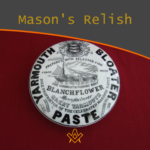 John and Timothy Coleman Blanchflower were initiated in Walpole Lodge, No. 1500, Norwich England on 2 December 1875; noted as a purveyor of ‘sauce’ to masons! |
 Jacob’s Ladder occupies a conspicuous place among the symbols of Freemasonry being on the First Degree Tracing Board, the most conspicuous and first seen by the candidate on his initiation – a vision of beauty and intrigue for the newly admitted. |
 During a detective hunt for the owner of a Masonic jewel, Paul Gardner discovered the extraordinary life of a true eccentric: Dr William Price, a Son of Wales, and a pioneer of cremation in Great Britain. Article by Paul Gardner |
 Paul Gardner tells the story of his transition from one rule book to another – from the Book of Constitutions to the Rule Book for Snooker! |
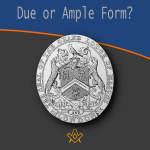 Due or Ample Form? What is ‘Ample’ form, when in lodges the term ‘Due’ form is used? |
 The Butcher, the Baker, the Candlestick Maker Paul Gardner explores the Masonic link between provincial towns’ craftsmen, shop keepers and traders in times past. Many remain in the modern era and are still to be found on the high street. |
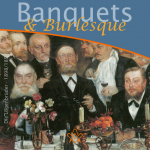 Masonic dining and banquets, at least for the annual Investitures, were lavish, and Kent Lodge No. 15, the oldest Atholl lodge with continuous working from 1752, was no exception. |
 The ‘cable-tow’ or ‘noose’ is used in Craft Masonry as part of the ritual, as are ropes and ties in other degrees - but what does it symbolise? |
 Paul Gardner reflects on those days of yore and the “gentleman footballer” in Masonry |
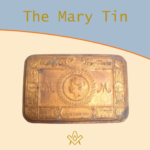 What is the Masonic connection with the 1914 Christmas Mary Tin |
 That Takes the Biscuit - The Patriot Garibaldi Giuseppe Garibaldi Italian general and politician Freemason and the Grand Master of the Grand Orient of Italy. |
 W.Bro. Paul Gardner looks at a mid 19th century artefact and ponders ‘Chairing’ |
Recent Articles: masonic history
 Protestantism and Masonic Influence in Brazil Discover the untold story of how Freemasons helped Southern Americans immigrate to Brazil post-Civil War, fostering economic and educational growth in Santa Bárbara d’Oeste and Americana. Learn about their pivotal role in establishing Protestant churches and ensuring the secularity of the Brazilian State amidst a Catholic-dominated society. |
 Explore the proper use of the sacred word in Brazilian Freemasonry through an analysis of Masonic literature and Bible translations. Uncover the errors in pronunciation and the need for corrections to maintain liturgical coherence in rituals. Discover insights on Masonry, rituals, and the Hebrew word Boaz. |
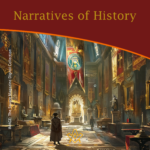 Narratives of History |
 A Very Royal Sesquicentenary |
 Unveiling the Enigma: Discover the Royal Society's Legacy and its Impact on Science. Delve into the fascinating history of the Royal Society, the prestigious UK academy shaping scientific progress since 1660. Explore its pivotal role in advancing knowledge, fostering collaboration, and unlocking the secrets of the universe. Prepare to be amazed! |
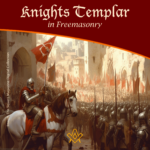 Knights Templar in Freemasonry Uncover the Mysteries of the Knights Templar in Freemasonry! Delve into the intriguing world where chivalry and symbolism intertwine. Discover the captivating rituals and ancient secrets behind the Knights Templar Masonic Orders. Explore the historical connection and delve into the enigmatic narratives that continue to fascinate enthusiasts today. Unveil the hidden truths now! |
 The Royal Arch stands as the rainbow of promise in the Ritual; it stands as the promise of the resurrection; of that which was lost and that it shall be recovered. The question arises as to whether the Master's Word was originally communicated in the Third Degree? On this point there is some diversity of opinion. Originally published in 1915, this insight into the Fourth Degree – the Holy Royal Arch – is as relevant today as it was over 100 years ago. |
 Unveiling the Mysteries of Druidism: Discover the Intriguing Connection with Freemasonry. Explore the ancient spiritual practice of Druidism and its fascinating ties to the enigmatic world of Freemasonry. Delve into the shared symbolism and rituals that have captivated minds for centuries. Unlock the secrets of these intertwined traditions today! |
 Uncover the legacy of freestone masons and their pivotal role in crafting medieval cathedrals. Discover the artistry behind their techniques, the hierarchy within their craft, and the enduring impact of their intricate carvings. A deep dive into the world of these master craftsmen awaits you! |
 Unearth the intriguing journey from Vincha Culture to Freemasonry. Discover how ancient building methods intertwine with modern Masonic philosophies. This exploration will shed light on the fascinating link between the Serbian term "shestarenye" and the symbolic significance of the compass in Freemasonry. |
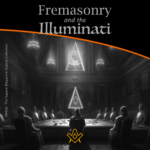 Freemasonry and the Illuminati Unravel the enigmatic world of Freemasonry and the Illuminati in our latest exposé. Dive into centuries-old mysteries, debunk conspiracy theories, and discover the truth behind these elusive societies. Are they puppet masters or mere myths? Join us as we dissect history and fact from fiction. |
 The Île des Templiers, or “Island of the Templars” lies within a leafy park in Paris. The execution site of Jacques du Molay, the last Grand Master of the Knights’ Templar bears a plaque with the epitaph ‘A cet endroit / Jacques de Molay / Dernier grand maître / de l'ordre du temple / a été brûlé le 18 Mars 1314’ (‘In this location / Jacques de Molay / Last grand master / of the order of the temple / was burned on 18 March 1314’) |
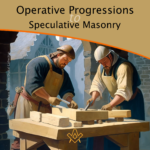 Operative Progressions to Speculative Masonry Both Operative and Speculative Masonry are an important part of the modern fraternity of Freemasonry, which combines elements of both traditions. Today, Freemasonry is a fraternity that is open to men of good character, who are interested in personal development and in making a positive contribution to their communities. |
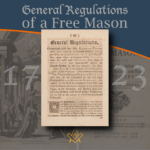 General Regulations of a Free Mason, 1723 General Regulations of a Free Mason as contained in Anderson's Constitutions of the Freemasons, published 1723. the Regulations are of great historical interest. Compiled by George Payne, the second Grand Master of the Premier Grand Lodge of England, they were printed in 1722/3, thus published just over five years after the formation of the Grand Lodge 1717. |
 The Genesis of the 1723 Book of Constitutions 2023, marks the three hundredth anniversary of the publication of the first printed Book of Constitutions of the Grand Lodge formally established in London two years previously. This is an anniversary whose significance extends beyond freemasonry. A paper by Andrew Prescott |
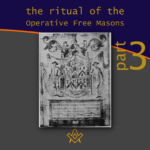 The Ritual of the Operative Free Masons - P3 Existing Operative Free Masons. The ritual I am about to refer, is that of "The Worshipful Society of Free Masons, Rough Masons, Wallers, Slaters, Paviors, Plaisterers, and Bricklayers." By Thomas Carr, M.D., P. M. Honorary Member of the Guild of Operative Free Masons |
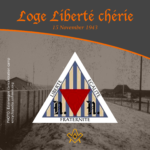 Liberté chérie was a Masonic Lodge founded in 1943 by Belgian Resistance fighters and other political prisoners at Esterwegen concentration camp. It was one of the few lodges of Freemasons founded within a Nazi concentration camp during the Second World War. |
 The Ritual of the Operative Free Masons - P2 If anyone doubts the fact that the formation of Speculative Free Masonry was due to and based upon Operative Free Masonry, it is quite easy to convince him of his error if he will only study the first Book of Constitutions. By Thomas Carr, M.D., P. M. Honorary Member of the Guild of Operative Free Masons |
 In 1881, Freemasonry rose from the ashes of a fire in the mining town of Kokomo, Summit County, Colorado. Corinthian Lodge No. 42, along with Kokomo, no longer exists but it holds the record of having been – at an elevation of 10,618 feet – the highest Masonic Lodge in the USA. |
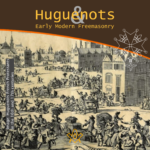 The Huguenots and Early Modern Freemasonry The Huguenots influence in the development of early modern Freemasonry at the time of the formation of the Grand Lodge in London around 1717 / 1723. |
 November is a month of reflection – perhaps due to the fact that we are getting close to the years' end – but also because Remembrance / Armistice Day (11 November) is a significant date in most countries' diaries. |
 Speculative Freemasonry, as practise by Grand Lodge of England, was officially born just over three hundred years ago, is today an international organisation, counting over six million members. It has been subjected to persecution, suppression, and abolition throughout its history. In its infancy, only a couple of decades after its official birth, it had already become a target. |
 The Ritual of the Operative Free Masons - P1 The original paper was written, first, to prove that Speculative Free Masonry was derived from Operative Free Masonry; second, to give some account of the Operative Free Masons, of their Ritual, and of their customs. By Thomas Carr, M.D., P. M. Honorary Member of the Guild of Operative Free Masons |
 American Fraternalism in the 19th and Early 20th Centuries The late 19th and early 20th centuries in the United States has been called the "Golden Age of Fraternalism." How did this come about and why was the idea of joining a fraternal organization so popular? We will explore this question and examine the regalia used by many fraternal organizations in this period. |
 Societas Draconistarum, meaning "Society of the Dragonists"– was a chivalric Order for selected nobility, founded in 1408 by Sigismund von Luxembourg, who through marriage became the King of Hungary (1387–1437) and later Holy Roman Emperor. The Order was fashioned after the military orders of the Crusades, requiring its initiates to defend the cross and fight the enemies of Christianity, in particular the Ottoman Empire. |
 The Perjured Free Mason Detected Was Samuel Prichard a perjured individual, or simply a misguided Freemason? Prichard's book "Free Masonry Dissected" published in 1730, is now used by many Masonic historians as a source of reference with regards to the introduction of the third degree into the Craft. But at the time it was published in 1730, it was not so well received by members of the Grand Lodge of England. |
 17th century and the Holy Royal Arch This article focuses on a period of transition between a point in time when we can safely and historically identify the first formation of what could be called as the ‘Royal Arch’ and the historical events that have preceded it. |
 Most Freemasons have heard the terms 'Operative' and 'Speculative' Masons, and this article helps to understand the difference: |
 Roberts' Constitutions of Freemasonry 1722 Published a year before Anderson's Constitutions, The Old Constitutions Belonging to the Ancient and Honourable SOCIETY OF Free and Accepted MASONS. Originally printed in London England; Sold by J. Roberts, in Warwick-Lane, MDCCXXII.(1722) |
 From 'Songs of religion and life', 1876 by John Stuart Blackie (1809-1895) |
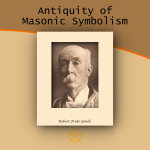 On the Antiquity of Masonic Symbolism Is the Symbolism of Masonry an inheritance derived from the old Masons who flourished before the era of the Grand Lodges (1717); or has it been borrowed from the Rosicrucians or others, after 1717? |
 Mason's Marks – from Egypt to Europe? Mason's marks have been a source of intrigue, not only to Freemasons but to historians and archaeologists. The use of simple pictograms have been employed for millennia by artisans to identify their work. But where did they originate and why? |
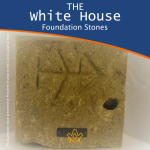 The White House Foundation Stones Further to the articles in our series on the history of the stone masons, we have a rather intriguing addition. During the 1950's renovation of the White House, President Truman retrieved more than 100 stone blocks with stonemasons marks. |
 What the Goose and Gridiron Tavern is in the ancient annals of London Freemasonry, The Green Dragon Tavern is to the memories of the Free-mason, of Boston and New England. |
 Auschwitz concentration camp: video photo article taken in 2013 |
 There are two things of importance happening this day - 27 January |
 Two approaches regarding the understanding of Freemasonry |
 Masonic Research in England c1930 An article which appeared in an American Masonic magazine, c1930 and which was reproduced in England, provoking a little controversy. |
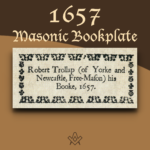 Masonic bookplates the ‘Brethren’s spiritual coats of arms and marks’ |
 The Unlawful Societies Act of 1799 Rebellious Freemasons and the 21st century |
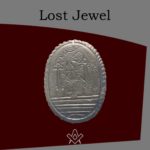 In 1912, Sarah Dowd of Dromore, Ireland, found a Masonic jewel dated 1517 - a date two hundred years before the establishment of Grand Lodge... |
 Freemasonry and Fascist Regime Interesting speech by the famous historian Prof. Aldo A. Mola, who links the fascist regime with the Masonic Associations. |
 Was famous Russian poet Alexander Pushkin a Freemason? And if so, was he a member of the lodge ‘for which all the lodges in Russia were destroyed’? |
 The Importance of Masonic Research Why is accurate - or authentic - Masonic research so important? The importance of making a daily advancement in Masonic knowledge is something that The Square is passionate about promoting. |
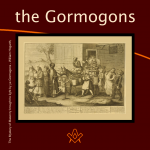 The Antient Noble Order of the Gormogons had a brief existence in the eighteenth century; they left few records or accomplishments, |
masonic knowledge
to be a better citizen of the world
share the square with two brothers

click image to open email app on mobile device






